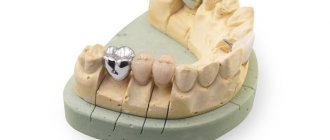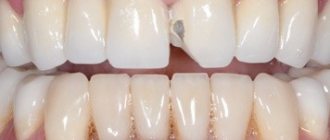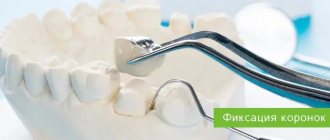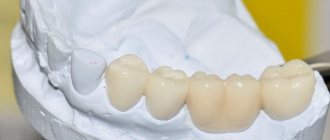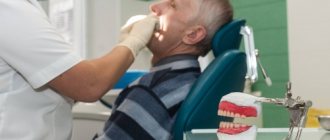From this article you will learn:
- what crowns are better to put on the front teeth,
- pros and cons of different crown options,
- How much does it cost to insert a front tooth?
When replacing anterior teeth, patients always place quite high demands on the aesthetics of dental crowns. The most important of them is that crowns on the front teeth should not be noticeable against the background of your own teeth, matching them in shape, color and transparency. The second important point is that crowns should not cause the gums to appear blue around them, because this will lead to its extremely aesthetically unsatisfactory appearance.
Today in dentistry there are only a few aesthetically acceptable options for prosthetics of anterior teeth. We are talking about prosthetics with metal-ceramics, zirconium crowns, as well as ceramic crowns “Emax” (glass-ceramics). Moreover, patients are equally often dissatisfied with both metal-ceramic and ceramic crowns, and below we will tell you why this happens and how to choose the most suitable option for you.
Metal-ceramic crowns for the front teeth: photo
The reasons for patient dissatisfaction lie not only in the low quality of work, but also in the initially incorrect choice of the type of crown, for example, not taking into account the level of transparency of the patient’s tooth enamel. The difficulty of choosing also lies in the fact that each of the types of crowns mentioned above (depending on the quality of the materials used and the manufacturing method used) can have either good or bad aesthetics. For example, let’s take economy-class metal ceramics made from budget ceramic mass “Duceram” (Germany).
Such metal ceramics can be found at an average price of 10,000 to 12,000 rubles. At the same time, the aesthetics of metal-ceramics made from budget ceramic mass will be very different from crowns that used more expensive ceramic mass, for example, “Noritake” (Japan), “Ivoclar” (Liechtenstein) or “Vita” (Germany). The average price for such metal ceramics in Moscow will be from 15,000 to 18,000 rubles. And if the metal ceramics were also made with the so-called “shoulder mass”, then you will have to add about 5,000 rubles to the price.
Important: we point out that within each type of crown there are numerous manufacturing options, the aesthetics of which will largely depend not only on the professionalism of the doctor and dental technician. Really good aesthetics will require more expensive materials and more labor-intensive manufacturing methods. But on the other hand, even choosing expensive ceramic crowns will not be an unconditional guarantee that you will get good aesthetics (since everything has its own nuances, which doctors often keep silent about).
Smile zone: indications for installing crowns
When communicating and expressing emotions, the teeth in the frontal region are involuntarily exposed. Their condition is visible to others, and this can cause psychological discomfort. If you are not happy with the appearance of your front incisors, contact your dentist. Even in the most advanced cases, when teeth are severely damaged, it is not necessary to remove them. After a thorough diagnosis, the doctor may recommend restoring teeth with crowns. A cap-like structure is placed over the remaining part of the tooth and takes over its functions.
Restoration with crowns is indicated in the following cases:
- aesthetic defects (chips, stains, cracks, diastemas, trema, curvature, etc.);
- single or complete destruction of teeth with preservation of the root;
- uneven gum line;
- bite pathology;
- pathological abrasion and discoloration of enamel;
- restoration of lost functions (biting, sharing food, diction).
The front incisors are not associated with the chewing function, so there are no strict requirements for the strength of the crowns. The doctor’s task is to recreate the anatomical shape and color of natural teeth, maintain their degree of transparency, and achieve a perfect match of sizes.
Options for restoration of the anterior region with crowns
For patients and dentists, the front teeth have always been the most problematic. In the last century, people were given metal crowns to preserve chewing function. There were no other alternatives. Such structures coped with the chewing function, but looked very unaesthetic, oxidized, caused allergies and galvanic syndrome (taste in the mouth). The most expensive and fashionable were gold dentures. Products made of ductile metal did not oxidize, did not cause rejection, and did not wear out for a long time. But the shiny yellow crowns were conspicuous and did not look like natural teeth, so over time, fashion changed, and this restoration technology was replaced by more modern techniques.
Today, patients have the opportunity to painlessly and quickly get rid of all defects associated with damage or loss of teeth in the frontal area, including the complete absence of dentition. In shape, shade and transparency, artificial analogs are almost no different from natural teeth, and their strength allows you to forget about any problems for a long time.
Initial examination and diagnosis
The decision that a crown needs to be placed on a tooth is made by an orthopedic dentist after examining the patient’s oral cavity and teeth, as well as performing a number of diagnostic measures. Based on the data obtained, the orthopedist will develop a treatment plan, which may include not only the installation procedure itself, but also a number of additional measures:
- Professional oral hygiene, which allows you to clean your teeth from plaque and tartar;
- Removal of severely damaged teeth that cannot be properly treated and restored with a filling;
- Treatment of caries and any other diseases of the teeth and gums diagnosed during examination;
- Tooth removal, treatment and filling of canals.
Note that depulping a tooth before placing a crown on it is not always done. The depulpation procedure involves removing the dental nerve, after which the tooth becomes more fragile and vulnerable to external factors. If a tooth has more than one root and is in good condition, doctors prefer not to remove the dental nerve and put a crown on a living tooth.
When drawing up a treatment plan, the question of what kind of crown will be placed on the tooth is also decided. Modern dental crowns are made from different materials and there is always the opportunity to choose the version of the prosthesis that will most suit the patient in terms of aesthetics, price and durability.
The drawn up treatment plan is agreed with the patient and after agreement the treatment process begins. The first step is to prepare the tooth for the installation of a crown.
Types of dental crowns
In any clinic, patients can choose the type of future crown themselves, but without the help of a doctor it is very difficult to understand the types of prostheses, as well as evaluate the advantages and disadvantages of orthopedic structures. When choosing a crown, it is important to know what material it is made of.
✔
Metal ceramics.
✔
Solid ceramic.
✔
Ceramics E-max.
✔
Ceramic coated zirconium.
Metal ceramics
Products of this type have a very solid base. They create structures by alloying various metals: chromium, nickel, cobalt, gold, titanium. To make the dental crown look natural, the metal base is covered with ceramics. Layers are applied to the frame, after which the crown is fired to impart strength and integrity.
- Acceptable cost
- Wear resistance.
- Reliability.
- Change in color of soft tissues.
- Allergy to metal.
- Blueness of the gums.
- Significant grinding of the tooth.
Solid ceramic
When restoring teeth in the frontal zone, doctors recommend all-ceramic structures for aesthetic single prosthetics. All-ceramic crowns are made from pressed ceramic without the addition of additional materials. These are quite fragile products, so they are not used in the chewing department.
- Biocompatibility.
- Great aesthetics.
- Durability.
- Fragility.
- Impossibility of performing bridge prosthetics.
- Relatively high price.
E-max ceramics
The problem of the fragility of a material such as ceramics was solved by glass-ceramic crowns E-max. They are not only very durable, but also distinguished by high aesthetics. This is an excellent option for front teeth. The E-max crown looks natural and does not stand out among natural teeth.
- Strength.
- Aesthetics.
- Reliability.
- Natural transparency.
- High price.
Zirconium
In the popularity rating, zirconium crowns have been occupying first place for several years. In terms of strength, aesthetic products made from zirconium dioxide are not inferior to metal, which makes it possible to create orthopedic structures of the highest quality. The hard material enhances the strength of teeth and restores their size and shape.
- Excellent biocompatibility and thermal conductivity.
- Inertness of the material.
- Kink resistance.
- Lack of natural transparency.
- High price.
Ceramic crowns on a zirconium frame
This type of crown is an excellent opportunity to combine strength, reliability, and high aesthetics. The products are as reliable and durable as metal-ceramic crowns. They do not deform during use and serve for a long time. The ceramic layer gives the artificial tooth a natural appearance.
- They look natural.
- Hypoallergenic.
- Withstands heavy loads without risk of damage.
- Quite a high cost.
Removable dentures made of nylon –
These are so-called soft removable dentures, made of elastic nylon (Fig. 13-15).
They are used for both complete and partial absence of teeth. Thanks to the properties of nylon, dentures made from this material can be made thinner and lighter than dentures made from plastic. In addition, nylon has a high degree of elasticity and flexibility, which makes these prostheses more comfortable to wear. In addition, removable dentures made of nylon have very good aesthetics and are practically invisible in the oral cavity. This is due to the fact that the gingival clasps of the nylon prosthesis (necessary for its fixation) are also made of pink nylon, which makes them invisible against the background of the pink shell of the gums. In turn, in plastic and clasp dentures the clasps are made of metal, and therefore they are clearly visible when they are in the smile line.
Dentures: photo
However, this is where the positive properties of such prostheses end. Reviews of nylon prostheses in the vast majority of cases are negative, which, paradoxically, is due precisely to the flexibility and elasticity of such prostheses. All the negative properties of nylon are fully manifested precisely when chewing pressure is transferred from a soft elastic prosthesis to the tissue of the prosthetic bed.
The high elasticity of the nylon prosthesis base leads to –
- to rapid atrophy of bone tissue under the prosthesis,
- rapid subsidence of the prosthesis and the need to replace it,
- painful chewing of food,
- the need for frequent corrections of the prosthesis,
- In addition, the prosthesis has a rough surface, which leads to the fairly rapid formation of a bacterial film on its surface.
Removable nylon dentures: price
For removable nylon dentures - the price is indicated for 2021 (the first figure is the cost in economy-class clinics, the second - in clinics of the middle price segment) ...
- complete removable denture – from 32,000 to 47,000 rubles.
- partial removable denture – from 26,000 to 40,000 rubles.
- butterfly denture made of nylon (for 1-2 teeth) – from RUB 17,000.
How is prosthetics performed: stages of crown installation
Restoring teeth in the smile area is no different from restoring chewing units. The doctor performs standard procedures, but does so taking into account high aesthetic requirements. Crowns in the smile area should restore all lost properties of the tooth: color, shape, size, functionality. For prosthetics to be successful, the procedure is carried out in several stages.
- When restoring a natural tooth, the doctor carries out preliminary treatment: removes caries, bleeding, plaque, changes old fillings, cleans root canals, etc. After all dental problems have been eliminated, if necessary, a support for the crown is installed. A stump tab or a special pin is used as a supporting element.
- The tooth is ground to the required size and an impression is taken, from which a plaster model of the crown is made in the laboratory. To protect the ground element, the patient is given a temporary crown.
- Using special cement, the finished crown is fixed to the front tooth. Well-installed structures should not differ in shape and color, put pressure on antagonist teeth, or cause the sensation of the presence of a foreign body in the mouth. If prosthetics are performed professionally, the patient quickly gets used to the new artificial teeth.
Note!
If you experience discomfort or pain in your mouth, visit your dentist. The doctor will take an x-ray, which will help determine what the problem is and whether the crown needs to be removed to solve it.
Own digital dental laboratory
The presence of a digital laboratory in the clinic improves the interaction between the orthopedist and the dental technician and reduces production time
- Digitalization of the production process reduces errors to a few microns
- Possibility to make a prototype and try on a crown on the day of modeling
- Accelerated production times - from 3 days
Is it possible to install a crown if there is no natural tooth?
In the absence of natural teeth, the integrity of the front row can be restored using implants. Carrying out implantation does not require turning of adjacent elements. The crown is placed immediately after the implantation of the artificial root. This process can last from 2 months to six months.
Before installing implants, the doctor takes impressions or conducts three-dimensional computer modeling to obtain a virtual model of the future structure. Before the permanent prosthesis is fixed, the doctor places a temporary crown on the patient.
Veneers or crowns: which is better?
You can restore your front teeth using veneers. Non-removable pads are attached to the turned elements. The procedure is much faster than prosthetics, but before making the final choice between veneers and crowns, consult your doctor. Durable ceramic onlays are classified as restoration methods in cosmetic (aesthetic) dentistry. Veneers that protect the surface of the tooth accurately imitate enamel, hiding all imperfections, but in case of significant damage and destruction they are not used. In these cases, crowns are installed.
Crown for front tooth: prices in Moscow
The cost of crowns is not affected by the type of teeth being restored, that is, it does not matter which elements the doctor prosthetizes, upper or lower. The price depends on the number of artificial crowns, the method of their installation, the material, and accompanying therapeutic procedures.
Information on the cost of treatment services can be found on the websites of dental clinics. We present average figures for Moscow.
The price of installing one metal-ceramic crown starts from 9,000 rubles. The cost of ceramic products is from 20,000 rubles. Costs for installing zirconium crowns start at 25,000 rubles. While the permanent crown is being made, the patient wears a temporary structure; it costs 1,500–2,000 rubles.
Removable dentures “Acry-free” –
Acry-free removable dentures are called new generation nylon dentures (although this name is not entirely correct). In fact, this type of denture is made from an advanced acrylic plastic that does not contain the monomer “methyl methacrylate.” Prostheses made from Acri-free plastic have a small degree of flexibility, which is significantly less than that of nylon prostheses.
Photos of Acry-free dentures –
Acry-free material was developed (Israel) for partial and complete removable dentures. It has amazing aesthetic properties, i.e. the base of the prosthesis is practically indistinguishable from the mucous membrane of the oral cavity. The clasps of the prosthesis are also made of translucent material, which makes them invisible - unlike the metal clasps of clasp and traditional acrylic dentures.
The cost of Acry-free prostheses - the prices below are indicated on a turnkey basis in mid-price clinics. The average price in Moscow for Acry-free prostheses in 2021 will be...
- partial removable denture – from 30,000 to 37,000 rubles.
- complete removable denture – from 40,000 to 47,000 rubles.
- prosthesis for 1-2 teeth – about 20,000 rubles.




